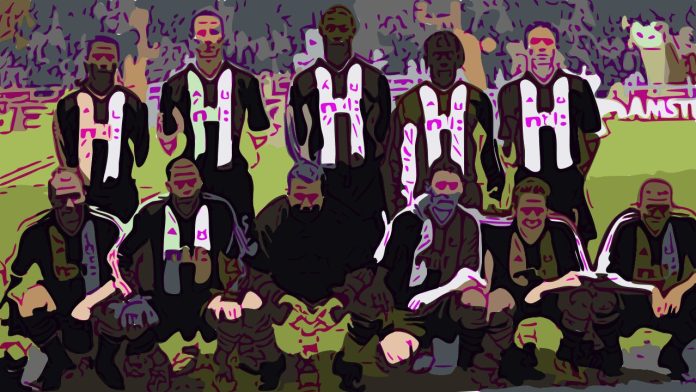Every club has its legends for different reasons. Some are simply so talented that they go down in folklore as the greatest players to ever play for that club. Some are statistically superior and score themselves into the history books. Others resonate with the fans. These players are unique because to be one of these players you have to understand what it is like to sit in the stand you are now playing in front. You have to have that desperate will to win that the fifty thousand people around you have. You have to play for them, be their representative on the pitch. Tommy Smith was just that.
Thomas Smith was born on 5th April 1945. He was an only child and his parents raised him as a Catholic. In a city like Liverpool religion still meant a lot to the children of Irish migrants and Tommy’s parents made sure he attended church every Sunday. This changed at the age of fourteen when his father passed away after a short battle with pneumonia. After seeing the drunken catholic priest stagger out of his after calling round to offer his condolences, Tommy decided he was done with Sunday mass and didn’t go back to church.
Upon leaving school Tommy joined the Anfield ground staff and the famous story goes that it was actually his mother who took him to Melwood and implored Bill Shankly to give Tommy a chance. Tommy joined the ground staff at Anfield as an apprentice and impressed Shankly so much in the youth teams that he bypassed two of the four reserve teams that apprentices usually have to endure. An aggressive centre forward, Tommy impressed the boss on his first day training with the senior squad when he beat Ron Yates to a header to score a goal. He was quickly signed onto an £18 p/w deal and never looked back.
Upon recognising the battling qualities Tommy possessed, Shanks took the shrewd decision to move the young lad from Lodge Lane from centre forward to centre half. He made his debut at the age of 18 coming on for Jimmy Melia in a 5-1 home win over Birmingham City. However, he did not feature again that season or the following season in which Liverpool won the first division. Tommy once told former Liverpool editor of the Liverpool Echo, John Thompson; “I went outside and walked right around the ground at the end of the game and after the crowd had gone home, John. Then I walked right around it once again that day, just to make sure it was true….But it was. I had actually played for the team I loved – for my Liverpool Football Club.” This, he said, was his proudest achievement.
He scored his first Liverpool goal against Blackburn Rovers at Ewood Park in 1964, playing inside-left in a 3-2 defeat. Tommy would be central to all success Liverpool had that season and when Liverpool knocked out Anderlecht in the quarter-final of the European Cup, Bill Shankly said of Tommy; “The game marked out Tommy Smith as a fine player. The boy has arrived.” Although Liverpool would be knocked in the semi-final by Inter Milan in one of the most controversial matches in European football history at the San Siro, that season would end in glory and Tommy was to be at the centre of it. Liverpool had never won an F.A Cup but would meet the Don Revie’s mighty Leeds United side at Wembley in May 1965. After initially going a goal up through Roger Hunt’s stooped header from six yards out, Billy Bremner equalised for Leeds to take the game to extra time. Liverpool would eventually win 2-1 thanks to a diving header from Ian St. John in the extra thirty minutes and every player in the team that day, including Tommy Smith, would be remembered as having won Liverpool’s first F.A Cup.
Tommy’s career went from strength to strength from that point onwards and he continued to win trophies for his beloved Liverpool. After sharing that year’s Charity Shield with Manchester United, Liverpool would win it outright a year later beating F.A Cup and Football League double winners Everton 1-0. But he was part of a Liverpool team that would not win another trophy during the remainder of the 1960s and that began to age. After being knocked out of the F.A Cup by lowly Watford in 1970, Shanks thought it time to have a revamp. The likes of St. John and Yates were replaced by younger players, like Steve Heighway and Emlyn Hughes. With Yates gone Liverpool needed a new captain, someone reliable and who had roots in the club and the city. Who better than Tommy Smith.
Under Tommy’s leadership, Liverpool reached the 1971 F.A Cup final but, after going 1-0 through Heighway, relinquished their lead. Goals from George Graham and Charlie George secured a historic 2-1 win for the Gunners as they claimed a league and cup double of their own. Liverpool, and Tommy, would not be denied silverware though. In 1973, Liverpool reached the UEFA Cup final which was then played over two legs. After beating Borussia Moenchengladbach 3-0 at Anfield, Liverpool were then beaten 2-0 back in Germany. An aggregate score of 3-2 was enough to secure Liverpool the UEFA Cup and make Tommy Smith the first Liverpool captain to win a European trophy.
Controversy followed the at the end of that season, however. Tommy would have the captaincy take off and given to Emlyn Hughes at the suggestion of the successor. This led to a long-running feud between Tommy and Emlyn. But this would stop the red steam train and more honours came their way when Liverpool won what was probably the most one-sided F.A Cup final of all time, beating Newcastle United 3-0 at Wembley thanks to a brace from Kevin Keegan and goal of Steve Heighway. Tommy Smith – a lad from Lodge Lane who used to jump the 27 bus through Kensington, past Newsham Park and get off outside Anfield with his boot around his neck – would now climb the steps of Wembley to the Royal Box and accept the F.A Cup from Princess Margeret. This was to be Bill Shankly’s last game as Liverpool manager as he shockingly retired a few weeks later.
Bob Paisley was given the reigns but the trophies kept coming. After winning another UEFA Cup in 1976 – this time beating Brugge 4-3 on aggregate – Liverpool would reach their first European Cup in 1977. A now 32-year-old Tommy had already began the phasing out process and had spent some time on loan at Tampa Bay Rowdies in 1976. He made it clear that this would be his last game for Liverpool and what a way to go. Liverpool took the lead through Terry McDermott but European footballer of the year, Alan Simmonsen, pulled Borussia Moenchengladbach level. With twenty-six minutes to go, Phil Neal stepped up to send a corner in from the right. A red shirt fizzed into the area and beat a defender to the ball, thumping it into the back of the net and giving Liverpool the lead. Nobody could quite believe Barry Davies’ commentary; “What a delighted scorer – it’s Tommy Smith!” Nobody deserved that moment more.

After a brief spell at LA Aztex in the North American Soccer League, Smith returned to Anfield for one last hurrah and was part of the side that retained the European Cup a year later, beating Brugge 1-0 at Wembley thanks to Kenny Dalglish’s goal. He then spent the following season of his career at Swansea City under John Toshack before retiring. He made six hundred and thirty appearances in a red shirt and scored thirty-eight goals, making the eighth on the list of Liverpool’s record appearances.
Tommy had a record for being a bit, shall we say, aggressive, and not unjustly. Shanks famously said that Tommy “wasn’t born – he was quarried” and notorious Leeds hardman Norman Hunter still described Tommy as a nice man even though his catchphrase was “come near me and I’ll break ya’ neck.” Tommy even acknowledged this himself, recounting the following anecdote regarding a run in with Jimmy Greaves; “I did warn players. When Tottenham striker Jimmy Greaves came out at Anfield one time I handed him a piece of paper. He said: ‘What’s this?’ I said: ‘Just open it.’ It was the menu from the Liverpool Infirmary.” Bob Paisley once said of Tommy’s impact on the team; “Seeing Tommy racing on to the field after having a couple of stitches inserted into a head wound could put courage into the most cowardly of hearts – as long as you were on his side!”
Following retirement, Tommy held a long-running column in the Liverpool Echo and did some after dinner speaking. He did a couple of interviews with Liverpool when asked to but mainly faded into the obscurity in later life. He was diagnosed with Alzheimer’s disease some time ago and was forced to give up his journalistic duties. His wife, Susanne, died four months ago and, according to a family statement on the Liverpool’s website yesterday, they believe that this accelerated Tommy’s demise. Tommy died on Friday 12th April 2019 at a nursing home in Waterloo, Merseyside.
Tommy Smith was not called the Anfield Iron for nothing. Yes, he was a hard bastard of a player and he loved a tackle. But two of the greatest managers this club, and the football world for that matter, has ever seen put their unshakeable trust in him. The fact Tommy was so versatile but never changed his style of play must surely make him one of the most underrated footballers in the history of the game. If you could embody The Kop, personify it, bottle its DNA and clone it into a footballing Frankenstein, the monster you would create would be Tommy. Above all though, Tommy Smith must be remembered for what he was – a lad from Lodge Lane who lived his dream in the exact same way in which we all would have. What a life to have lived.


